If you're on a quest to see some really unique animals in Yosemite, forget about the bears. Think smaller. Yes, marmots are cute, but they're still pretty big (as the largest of Yosemite's squirrels) and you'll have to think even smaller than the smallest mouse.
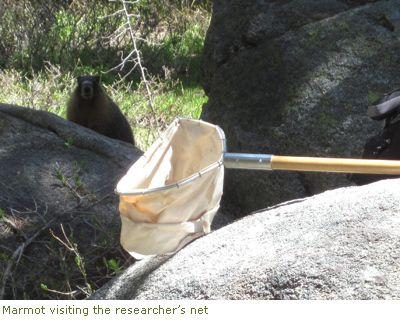
On June 6, 2014, a small group of Yosemite Ranger Naturalists from the Mather district set out to find some of these elusive creatures…with nets and water shoes. Our destination was the Middle Fork of the Tuolumne River near White Wolf and no matter how quietly we walked and sat along the river bank, we couldn't actually see them until we started turning over rocks. Then…wholly cow! Are these animals even from our planet?
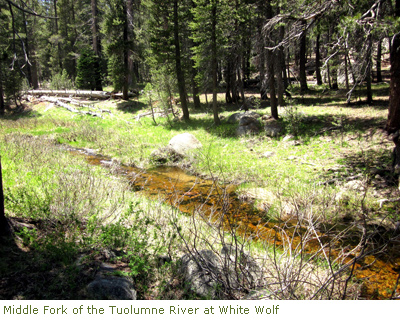
We had a research permit in hand and were collecting what are known (very unromantically) as benthic macroinvertebrates (BMI) which means something like "spineless bottom-dwelling animals that are small but big enough to see with the naked eye." Really we should call them something like the "River Changelings" and perhaps there'd even be BMI jams near all of our rivers as visitors parked vehicles in all sorts of inappropriate places just to get out and turn over some rocks to see what's going on down there.
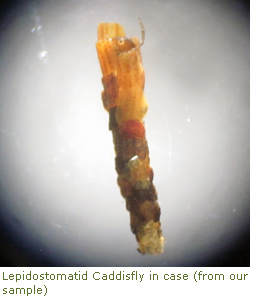 Some of my favorites are the caddisflies, some of whom build unique homes out of sand, rocks or plant matter. They mostly stay inside of these little "cabins" to stay safe from predators (until they grow and need to build a bigger one). They move around by sticking out their six legs, conveniently located near the fronts of their long bodies, and they crawl around the stream bottom with their little cases dragging behind. In fast-flowing rivers the extra weight might also help keep them from washing away. At some point in their lives these caterpillar-like insects seal themselves in their cases, pupate and then emerge as flying adult insects that don't look much like their stream-dwelling children will look.
Some of my favorites are the caddisflies, some of whom build unique homes out of sand, rocks or plant matter. They mostly stay inside of these little "cabins" to stay safe from predators (until they grow and need to build a bigger one). They move around by sticking out their six legs, conveniently located near the fronts of their long bodies, and they crawl around the stream bottom with their little cases dragging behind. In fast-flowing rivers the extra weight might also help keep them from washing away. At some point in their lives these caterpillar-like insects seal themselves in their cases, pupate and then emerge as flying adult insects that don't look much like their stream-dwelling children will look. 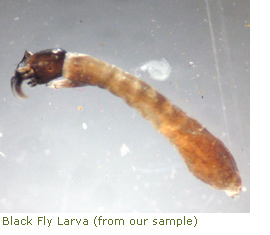
Then there are the black flies that start their lives in the water as little asymmetrical worm-like creatures with feathery fans on their mouths. They stick to rocks by hooks on their abdomens that attach to little silk pads that they've put there. If conditions aren't right for them where they hatch from their eggs, they might "rappel" downstream on a silk thread that, like the silk pads, they secrete out of their mouths. When it's time for them to leave their childhood home in the river, they complete the rites of passage to adulthood a bit more like what we're used to with butterflies –binding themselves up in a cocoon for a while and then emerging in an air bubble that floats them to the river's surface where they fly away as a familiar insect of summer. We found a lot of black fly larvae this year.
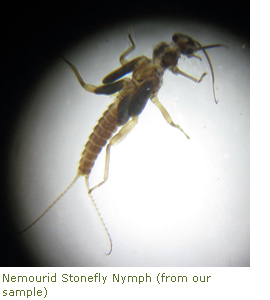
Don't forget the stoneflies, lovers of the cleanest, coldest, and fastest of rivers. You can usually recognize them by their two tail-like "cerci" coming out of the rear of their bodies like antennae that were attached on the wrong end. Like many other insects, stoneflies spend a large part of their lives outgrowing their bodies. Stoneflies may shed their bodies 10-30 times during their youth in the water, and then finally crawl out of the river only to have their backs split open one last dramatic time. Then yet another flying insect of benthic origin crawls out and flies away.
So why were we on a quest to capture some of these amazing stream-dwellers rather than just out enjoying them in their native home? It turns out that you can learn a lot about water quality in rivers by looking at what lives there. Different organisms have different sensitivities to different types of disturbances so for many years aquatic biologists throughout California and the world have studied River Changelings (A.K.A. BMI) to get a sort of report card for water quality. We started this project as something that we hope will become an annual event –a citizen science attempt to record some of what's living in this river over time. We also hope it might help us quantify some anecdotal changes that those of us who've been around for a few years think we're noticing in the river, such as more algae. Climate change might be one factor influencing changes in Yosemite ecosystems in upcoming years. Similar to the sort of change that we see in some of the River Changelings, we are anticipating that some effects of climate change might also be dramatic… though likely less exquisitely adapted to fitting into Yosemite's intricate ecology.
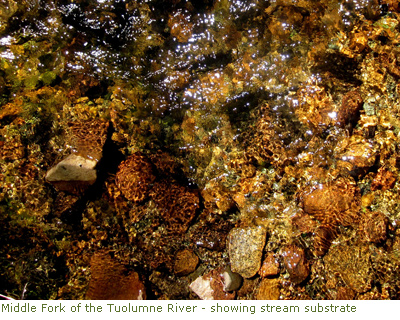
So next time you're crossing a creek on a Yosemite trail, or wandering by your own neighborhood stream for that matter –they're just about everywhere –be aware that River Changelings are lurking, and probably in great numbers. Not only are they masters of change and strange behavior but they also tell a story of water quality. Not to mention the fact that they are founding and essential members of our planet's food webs that are tightly woven together with the more obvious birds, bears and us.
Here's a list of what we found by sampling the Middle Fork of the Tuolumne River, just downstream of White Wolf along three ten meter stretches within a 150 meter reach on June 6, 2014:
| Organism | Number Found |
| Ephemeroptera - Mayflies | |
| Heptageniidae –Flatheaded Mayfly | 1 |
| Leptophlebliidae –Prongill | 1 |
| Plecoptera - Stoneflies | |
| Chloroperlidae - Green Stonefly | 19 |
| Nemouridae - Spring Stonefly | 16 |
| Taenioptyrigidae - Winter Stonefly | 1 |
| Unidentified stonefly | 1 |
| Trichoptera - Caddisflies | |
| Rhyacoophilidae - Freeliving Caddisfly | 1 |
| Lepidostomatidae - Bizarre Caddisfly | 13 |
| Diptera - True Flies | |
| Chironomidae - Non-biting Midge | 15 |
| Simuliidae - Black Fly | 364 |
| Coleoptera - Beetles | |
| Elmidae - Riffle Beetle | 8 |
| Other | |
| Class Oligiochaeta - Aquatic Earthworm | 2 |
| Class Bivalvia - Clam | 1 |
| Phylum Nematoda - Nematode | 5 |
